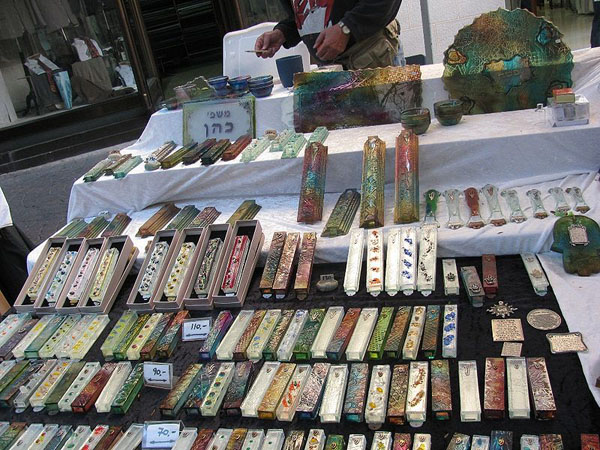
A mezuzah has two parts: a parchment scroll on which specified Biblical verses are hand-written, and a protective case for the scroll. The mezuzah derives its name from the Hebrew word mezuzah which means ‘doorpost’ – since the passage on the scroll includes the words ukh’tavtam al mezuzot bei’teikhau’vish’arekha (‘you shall place them [the words on the scroll] on the doorposts of your home and on your gateways”). Of the two parts, the scroll is the more important as the mezuzah is not kosher (valid) without the scroll, whereas the case is required merely to protect the scroll, although it is customary (but not obligatory) to decorate the case.
The parchment within the mezuzah is inscribed on the front with the words of Deuteronomy 6:4-9 and 11:13-21. On the back is written ‘Shaddai’, which means ‘Almighty’ and is one of the names of God, and an abbreviation for ‘guardian of the doors of Israel’. Shaddai or the Hebrew letter ‘shin’ is displayed on the front of the container or is otherwise visible through a hole. Kabbalistic symbols and inscriptions once appeared as an addition to the quotations on the parchment, to accentuate the protective mechanism of the mezuzah. ‘Shaddai’, which appears on the back of the parchment, is a remaining example of this.
Historically, the mezuzah can be dated back to the time when the Jews were slaves in Egypt. Originally an abbreviated version of the daily prayer known as the Shema was carved into the doorpost of a Jewish home. This practice evolved into a piece of parchment with the 22 lines of the Shema written on it and fixed to the doorpost. The Shema reinforces the Oneness of God. Later, a hollow reed was used to protect the parchment, which finally developed into a container similar to the ones customarily seen today.

Some people believe that the mezuzah serves as an amulet, to protect the home and to bring good luck. A more prevalent view of the significance of the mezuzah is that it doesn’t necessarily fortify us physically, but that it protects us against sinning by reminding us of God’s commandments.
A 13th century Jewish scholar and physician named Maimonides claimed that the mezuzah served as a constant reminder that the affairs of the rest of the world were unimportant: “By the command of the mezuzah, man is reminded, when entering or departing, of God’s Unity, and is stirred into love for him. He is awakened from his slumber and from his vain worldly thoughts … This contemplation brings him back to himself and leads him on to the right path.”
According to Maimonides it was a distortion to believe that the mezuzah acted as an amulet, and that this detracted from its true meaning and purpose: “Fools pervert for temporal benefit the religious duty of the mezuzah, of proclaiming the Unity of God and the love and service due him…”
Orthodox Jews consider it is a religious duty to have a mezuzah on every doorframe of their house (except ones leading to bathrooms), whereas traditional but non-Orthodox Jews often satisfy themselves with having a mezuzah just on the front door to their dwelling.
The mezuzah is one of many symbols in Judaism, which act as an identifier, a constant reminder of one’s obligation towards God as well as an affirmation of the Unity of God.

LINKS
United Synagogue: Why Do Some People Kiss the Mezuzah when Entering or Leaving their Home? (video, 2 minutes, 41 seconds)
Aish HaTorah: Mezuzah: The Inside Story
Being Jewish: Mezuzah: The Jewish Lightning Rod


